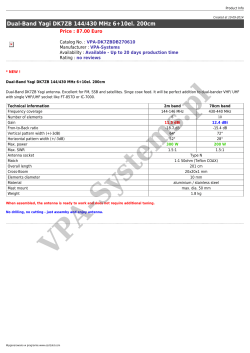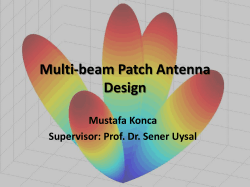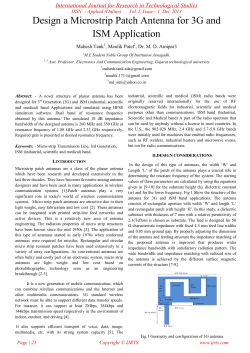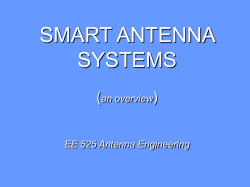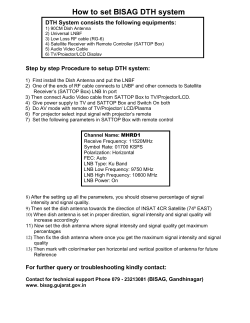
Selecting Receiving Antennas for Radio Tracking Isanti, Minnesota 55040
Selecting Receiving Antennas for Radio Tracking Larry B Kuechle, Advanced Telemetry Systems, Inc. Isanti, Minnesota 55040 lkuechle@atstrack.com The receiving antenna is an integral part of any radio location system. The receiving antenna intercepts the electromagnetic energy propagating through space and converts this energy into electrical energy that can be processed by the receiver. Antennas are physical devices, meaning they have some structure and occupy space. They may be connected directly to the receiver input or they may be attached by means of a cable. Choice of receiving antenna depends on several criteria. Among these are frequency, logistics, location method and required gain. Some of these requirements are mutually exclusive. Receiving antennas for radio location, often called radio tracking, may be grouped into three categories: omni directional dipoles, directional yagis and directional loops. All antennas are frequency dependent. For optimum efficiency, the length of the antenna elements should be a minimum of one-half wavelength. A more technical description would be that the antenna elements must define a sphere with a half wavelength diameter. It should be noted that antennas are passive devices and can only have gain in one direction by reducing gain (sensitivity) in another direction. This gain is often referred to as directive gain. In discussing receiving antennas there are a number of terms which should be defined. These are listed below. Definition of terms: Isotropic radiator A hypothetical antenna having equal radiation intensity in all directions. Null The region of radiation pattern where the amplitude goes through a minimum value. Front to back ratio The ratio of the maximum gain in the forward direction compared to the gain in the rearward direction. Beam width The angle in degrees defining two equal power points. The angle usually defines the points where the power is one-half the peak power. ( 3dB point) The gain of an antenna expressed in decibels relative to an isotropic radiator. Gain, dbi Gain, dbd The gain of an antenna expressed in decibels relative to a half wave dipole. Polarization Indicates the direction of the electric field of the antenna. For radio location of animal transmitters this can be simplified to defining the direction of the elements of the antenna. If the elements are vertical, the antenna is vertically polarized and if they are horizontal, it is horizontally polarized. The three antenna parameters most relevant for radio location are gain, beam width and size. We want to choose the antenna with the highest gain because it would result in greatest reception range. Since we are direction finding, we would also want to choose an antenna with the smallest beam width. This would make it easier to pinpoint the signal source. Unfortunately these two parameters are directly related to size. As the 1 antenna gain increases and the beam width narrows, the antenna size (length) increases. Dipole Antennas: Dipole antennas are the antenna of choice where an omni directional antenna is required (coverage in 360 degree azimuth). A half wave dipole has a gain of 2.15 dB compared to an isotropic radiator. (Figure 1 ) Dipoles of lengths greater than one-half wavelength will have gains greater than 2.15 dBi. These higher gains come at the expense of narrower beams and the introduction of nulls in the antenna elevation pattern. Because of these nulls ( Figure 2) we do not recommend dipoles with gains greater than 5 dB. The position of these nulls is also dependent on ground proximity, making their behavior hard to predict unless they are mounted on high towers. Figure 1. Directivity pattern of half wave dipole in azimuth and zenith direction Quarter wave antennas will behave as dipoles if they are mounted on an infinite ground plane. These antennas are most often available as magnetic rooftop mounts. To have a predictable behavior and to achieve their specified gain, they must be mounted on a large flat metal surface. Gain of these antennas is 2.15 dBi. The metal surface should extend at least one-half wavelength on each side of the base of the antenna. Typical applications of dipole antennas are monitoring presence or absence of animals and locating fish from a boat on a river. Figure 2. Directivity Pattern of 5/8 wavelength dipole antenna. Table 1 Comparison of Yagi Antennas Antenna H 3 Element 4 Element 6 Element 9 Element Gain (dBi) 7.0 8.5 9.4 10.2 13.0 Yagi Antennas: Yagi antennas are the most commonly used antenna for direction finding in animal tracking applications. They are multi-element array antennas available with two to nine elements. Actually, there is not a limit to the number of elements; however nine 3 dB Beam Width Vertical (degrees) Horizontal (degrees) 108 66 90 54 81 58 73 56 49 43 is probably a practical upper frequencies below 200 MHz. limit for Although the commonly used H antenna is not a yagi, it is a phased array and behaves similarly to the yagi. The size of a yagi antenna is defined by the need to have the elements be approximately 2 one-half wavelength long and the spacing between elements be approximately one-fourth wavelength. Thus a four element yagi will be about three-quarter wavelength long by one-half wavelength in size. At 150 MHz, this will result in an antenna with a one meter by one-and-a-half meter dimension. Wavelength is equal to the speed of light/ frequency. Yagi antennas will have a different gain pattern depending on whether the antenna elements are vertical or horizontal. (Figures 3-7) This is the result of multiplying the effect of the dipole pattern of the individual elements by the pattern resulting from the phasing (spacing) of the elements. In examining the patterns for the different yagi antennas you will notice the difference between vertical and horizontal polarization decreases as the number of elements increases. The maximum forward gain is the same in either the horizontal or vertical orientation. (Table 1) The choice of which yagi antenna to use is dependent on the radio location method. If the method is location by homing, the choice can be made on the basis of size verses gain. In most cases handling convenience (size) will outweigh advantages in gain. Directional accuracy (beam width) is not particularly important in homing. The two element H antenna or the three element yagi antenna will suffice in most applications. H Antenna Four Element Yagi 3 Figure 3. Directivity pattern of an H antenna in the vertical and horizontal planes. Beamwidth (3dB) is 108 degrees in the vertical plane and 66 degrees in the horizontal plane. Figure 5. Directivity of a four element Yagi antenna. Beamwidth (3dB) is 81 degrees in the vertical plane and 58 degrees in the horizontal plane. Figure 4. Directivity pattern of a three element folding Yagi antenna. Beamwidth (3dB) is 90 degrees in the vertical plane and 54 degrees in the hozizontal plane. Figure 6. Directivity pattern of a six element Yagi . Beamwidth (3dB) is 73 degrees in the vertical plane and 56 degrees in the horizontal plane. 4 As shown in figures 8,9,10, and 11; the directivity pattern and gain of stacked is dependent on the spacing. There is not an optimum spacing. Spacing is usually dictated by the physical structure or the need to maintain a maximum size. An example of a stacked array on the top of a vehicle is shown in figure 12. Figure 7. Directivity pattern of a nine element Yagi. Beamwidth (3dB) is 49 degrees in the vertical plane and 43 degrees in the horizontal plane. Stacked arrays can be most easily implemented using a zero degree hybrid combiner for the peak at center system and a 180 degree hybrid combiner for the center null system. It should be noted that the antennas must be matched and the electrical length of the coax cables between the antenna and the combiner must also be matched. Switchboxes are also available that allow switching between null and peak modes. The switchboxes operate by switching different lengths of transmission lines to achieve desired phasing. Directional accuracy is enhanced by using an antenna with a narrow beam width. Since beam width is directly related to yagi antenna length, the longer the antenna, the better its performance. Cochran and Pater1 measured standard deviation for various yagi antennas. Their data indicates a standard deviation of bearing errors ranging from 24 degrees for HAdcock to 15.7 degrees for four element yagi under densely wooded conditions. For frequencies less than 250 MHz, a four element yagi is about the largest practical antenna for hand-held use. For tower or vehicle mounted antennas, longer yagi antennas may be used yielding a narrower beam width. Stacked Arrays: Another alternative for applications where high angular resolution is required is to use a stacked pair of yagi antennas fed either in 0 degrees phase or in 180 degrees phase. In the former case, the system will have a twice (3dB) gain over a single yagi of the pair because the signals received by each of the antennas are added together in-phase yielding the sum of the two signals.(Figure 10) It will also have two nulls offset from center depending on the spacing between the pairs. These nulls can be used for direction finding even though they are offset from center. If the antenna is fed 180 degrees out of phase, the null in the antenna pattern will be in the center, pointing directly to the signal source. (Figure 8) Maximum gain in this case will be slightly greater than the gain of a single yagi of the pair. Figure 8. Directivity pattern of two four element Yagis spaced 0.75 wavelengths apart. Antennas are fed out of phase (180 degree combiner) Maximum gain is 10.2dBi. 5 Table 2. Effects of Stacked Yagi Spacing Antenna Spacing Wavelengths (λ) 0.75λ 1.0λ 1.5λ 2.0λ 0 Degree Combiner Max Gain 12.3dB 12.6dB 12.4dB 12.4dB 180 Degree Combiner First Null (deg) ±41.5° ±30° ±20° ±14.5° Figure 9. Directivity pattern of two four element Yagis spaced 1.5 wavelengths apart. Antennas are fed out of phase (180 degree combiner). Maximum gain is 11.9dBi. Figure 10. Directivity pattern of two four element Yagis spaced 0.75 wavelengths apart. Antennas are fed in phase ( 0 degree combiner). Maximun gain is 12.3dBi. Max Gain 10.2dB 11.0dB 11.9dB 12.1dB First Peak (deg) ±30° ±25° ±18° ±14° Figure 11. Directivity pattern of two four element Yagis spaced 1.5 wavelengths apart. Antennas are fed in phase (0 degree combiner). Maximum gain is 12.4dBi. Figure 12 Truck mounted stacked Yagi antennas. 6 Loop Antennas: Loop antennas are used in low frequency applications where the size of a Yagi antenna may be inappropriate. They may also be used at higher frequencies for close in direction finding. As shown in the figure below, they have what is often referred to as a figure 8 pattern (Figure 13). The null is perpendicular to the plane of the loop. Loops are always used in the vertically polarized mode. The gain of a loop antenna is much less than the gain of a dipole or Yagi. Another problem with loop antennas is their bandwidth is narrow, meaning they must be tuned to the specific frequency range of use. Typical 3dB bandwidths for loops are 200-300kHz, while for Yagis 4 MHz or more is typical. Figure 13. Directivity pattern of a loop antenna. Null is perpendicular to the plane of the loop. Coaxial Cables: The antenna is usually connected to the receiver with a coaxial cable. A coaxial cable has a center conductor surrounded by a dielectric insulator, usually polyethylene. This is then surrounded by a braided shield which is covered by a protective material. The signal is carried on the inner conductor while the braided outer conductor acts as a shield to outside noise and also acts as a ground return path. Coaxial cables are available in several impedance levels. In radio location service 50 ohms is used to match the 50 ohm impedance of the receiver and antenna, Cables also come with different end connectors depending on the frequency range and application. In our applications BNC connectors are the most common. The most commonly used cable is RG58. All cable has some loss depending on frequency and cable type. Loss in the cable reduces the signal available to the receiver. A loss in the cable effectively increases the noise figure of the receiver by any equal amount. The significance of this increased noise figure depends on whether the area of operation is electrically quiet or not. Cable loss can be reduced by selecting a cable with lower loss. Low loss cables are more expensive and generally larger and heavier. In most cases we would want to keep cable losses to less than 4-5dB. The chart below shows the loss for RG8 and RG58 cable. 7 Coax Cable Loss 20 Attenuation (dB) 15 RG-8 50MHz RG-8 150MHz RG-8 200MHz RG-58 50MHz RG-58 150MHz RG-58 200MHZ 10 5 0 0 20 40 60 80 100 Length (meters) Figure 14. Cable loss versus cable type and frequency as function of cable length. Literature Cited 1. Cochran, W. W., and L. L. Pater. 2001. Direction finding at Ultra High Frequencies (UHF): improved accuracy. Wildlife Society Bulletin 2001, 29(2):594-599. 8
© Copyright 2025
